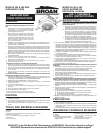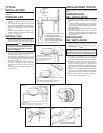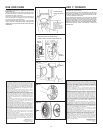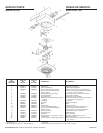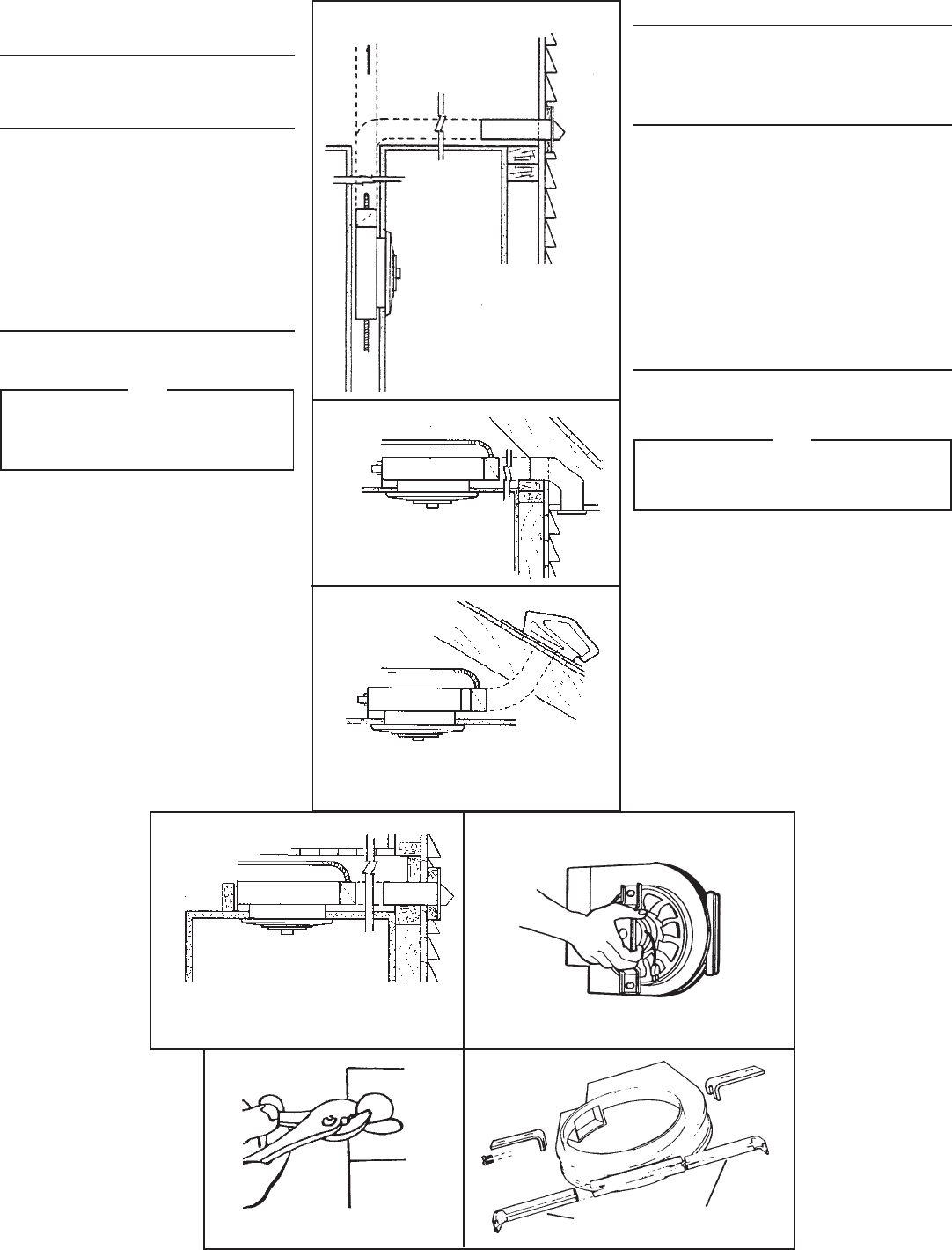
TYPICAL
INSTALLATIONS
Please see figures 1 through 4 for examples of typical
installation.
PREPARE FAN
1. Unplug fan motor. Remove motor assembly by
loosening mounting screws and rotating motor
(FIG. 5).
2. Use care when handling motor bracket assembly
to prevent damage to blade. Do not set down as-
sembly with weight of motor resting on the blade.
3. Remove top or side knock out from fan housing
(FIG. 6).
4. Fasten mounting brackets to fan housing. Ad-
justable brackets will fit between joists or studs
up to 24” on center (FIG. 7).
INSTALL FAN
1. Adjust mounting brackets so that plaster ring on
housing will be flush with finished wall or ceiling.
Nail or screw brackets to joists or studs (FIG. 8)
NOTE
IF FAN IS INSTALLED ABOVE A COOKING SUR-
FACE, GRILLE CENTER MUST BE LOCATED AT
LEAST 58” ABOVE FLOOR OR AT LEAST 22”
ABOVE HEAT SOURCE.
2. Run wiring to fan and attach wire to housing with
proper connector for type of wire used. Make elec-
trical connections as shown in Figure 9.
3. Attach ductwork. Run ductwork to roof or wall
cap. See “Typical Installations” ((FIGS. 1-4) Make
sure that both fan damper and damper inside roof
cap open freely (FIG. 10).
4. After finished ceiling is installed, install motor
and plug in. Spin blade by hand to make sure
that blade does not strike anything in housing
(FIG. 11).
5. Install grille with knob and stud provided in plas-
tic bag (FIG. 12).
FIG. 2
FAN INSTALLED BETWEEN JOISTS
DUCTING TO EAVE ELBOW IN THE EAVE.
VENTILADOR INSTALADO ENTRE VIGAS
CON DUCTOS HACIA EL CODO DEL
ALERO EN EL ALERO.
FIG. 3
FAN INSTALLED BETWEEN JOISTS DUCTING TO ROOF
CAP.
VENTILADOR INSTALADO ENTRES VIGAS CON
DUCTOS HACIA LA CUBIERTA DEL TECHO.
FIG. 4
FAN INSTALLED BETWEEN JOISTS AND DUCTING TO WALL CAP
IN OUTSIDE WALL.
VENTILADOR INSTALADO ENTRE VIGAS CON DUCTOS HACIA LA
CUBIERTA DE LA PARED EN LA PARED EXTERIOR.
FIG. 5
FIG. 7
ADJUSTABLE BRACKETS
MÉNSULAS AJUSTABLES
INSTALACIONES TIPICAS
Veánse las figuras 1 a 4 para ver ejemplos de instalaciones
típicas.
PREPARACION
DEL VENTILADOR
1. Desenchufe el motor aflojando. Retire el conjunto del
motor los tornillos de montaje y girando el motor (FIG.
5).
2. Use especial cuidado al manejar el conjunto del motor
prevenir daño a la hélice del ventilador. No establezca
al conjunto con el peso del motor que se reclina sobre la
hélice del ventilador.
3. Retire el disco removible de arriba o del lado de la carcasa
del ventilador (FIG. 6).
4. Asegure los soportes de montaje a la carcasa del
ventilador. Los soportes ajustables se ajustarán entre
vigas o entramado de pared de hasta 60,96 cm (24 plg.)
en el centro (FIG. 7).
INSTALACION
DEL VENTILADOR
1. Ajuste los soportes de montaje de manera que el anillo
de yeso en la carcasa esté a nivel con el techo o la pared
acabada. Clave o atornille los soportes a las vigas o
soportes (FIG. 8).
NOTA
Si se instala el ventilador encima de una estufa, el
centro de la rejilla debe rejilla colocarse a una
distancia mínima de 1,47 metros (58 plg.) del suelo o
a medio 0,56 metros (22 plg.) de distancia de la estufa.
2. Instale el cable hasta el ventilador el ventilador y sujete
el cable a la carcasa con los conectores
correspondientes para el tipo de cable que se use. Haga
las conexiones eléctricas tal como se muestra en la figura
9.
3. Instale los conductos. Instale los conductos hacia la
cubierta de la pared o el tejado. Vea la sección
“Instalaciones típicas” (FIGS. 1-4). Compruebe que el
amortiguador del ventilador y el amortiguador de dentro
de la cubierta del techo se pueden abrir libremente (FIG.
10).
4. Después de se haya instalado el techo acabado, instale
el motor y el enchufe. Gire la paleta con la mano para
comprobar que no golpea contra algo en la carcasa (FIG.
11).
5. Instale la rejilla con mando y tornillo de la rejilla que se
incluyen en la bolsa de plástico (FIG. 12).
2
FIG. 6
FIG. 1
TO ROOF
CAP
A LA
CUBIERTA
DEL
TECHO
FAN INSTALLED IN SIDEWALL AND
DUCTING TO WALL CAP IN
OUTSIDE WALL OR TO ROOF CAP.
VENTILADOR INSTALADO EN
PARED LATERAL Y CONDUCTOS
HACIA LA CUBIERTA DEL TECHO
POR LA PARED EXTERIOR



